Effect of Dose Rate on Tribological Properties of 8Cr4Mo4V Subjected to Plasma Immersion Ion Implantation
Abstract
1. Introduction
2. Experimental Details
3. Results and Discussions
3.1. Surface Roughness of the Surface Layer Treated by High-Dose-Rate Ion Implantation
3.2. Phase Composition of the Surface Layer Treated by High-Dose-Rate Ion Implantation
3.3. Elemental Percentage of the Surface Layer Treated by High-Dose-Rate Implantation
3.4. Nanohardness Analysis of the Surface Layer Treated by High-Dose-Rate Implantation
3.5. Contact Angles of the Surface Layer Treated by High-Dose-Rate Implantation
3.6. Surface Free Energy of the Surface Layer Treated by High-Dose-Rate Implantation
3.7. Coefficient of Friction of Samples Implanted by Different Dose Rates
3.8. Wear Behavior Analysis of Samples Implanted by Different Dose Rate
4. Mechanism Discussion
5. Conclusions
- High-dose-rate ion implantation had a significant efficiency on 8Cr4Mo4V bearing steel.
- For the implanted samples with the different dose rates of 2.60 × 1017 ions/cm2·h, the roughness of Ra decreases from 24.8 nm to 10.4 nm, which is decreased by 58.1% for the dose rates of 7.85 × 1017 ions/cm2·h.
- The nanohardness of implanted samples improved notably as well, especially in the dose rate of 5.18 × 1017 ions/cm2·h, which reaches a higher value of 16.3 GPa, accompanied by an enlarged hardened region.
- For the implanted samples, the smallest and highest contact angles of 76.8° and 82.4° are obtained at the dose rate of 7.85 × 1017 ions/cm2·h and 1.04 × 1018 ions/cm2·h, respectively.
- The wear resistance was greatly improved by an optimal dose rate ion implantation, accompanied by reduced wear weight loss and lower coefficient of friction compared with those without high-dose-rate ion implantation.
Author Contributions
Funding
Data Availability Statement
Conflicts of Interest
References
- Jiang, H.; Song, Y.; Wu, Y.; Shan, D.; Zong, Y. Macrostructure, microstructure and mechanical properties evolution during 8Cr4Mo4V steel roller bearing inner ring forging process. Mater. Sci. Eng. 2020, 798, 140196. [Google Scholar] [CrossRef]
- Lu, H.; Su, H.; Mei, C.; Yang, Q.; Xu, Q.; Xiang, D.; Zhou, T. Effects of B, N, Cr and Mo ion implantation on the corrosion resistance of pure iron and its alloys (GCr15 and Cr4Mo4V). Vacuum 1989, 39, 187–189. [Google Scholar]
- Wang, F.; Zhou, C.; Zheng, L.; Zhang, H. Corrosion resistance of carbon ion implanted M50NiL aerospace bearing steel. Prog. Nat. Sci. Mater. Int. 2017, 27, 615–621. [Google Scholar] [CrossRef]
- Yu, X.; Wei, Y.; Zheng, D.; Shen, X.; Su, Y.; Xia, Y.; Liu, Y. Effect of nano-bainite microstructure and residual stress on friction properties of M50 bearing steel. Tribol. Int. 2022, 165, 107285. [Google Scholar] [CrossRef]
- Jiang, T.T.; Zheng, Q. Bearing failure impulse enhancement method using multiple resonance band centre positioning and envelope integration. Measurement 2022, 200, 111623. [Google Scholar] [CrossRef]
- Harris, T.A.; Skiller, J.; Spitzer, R.F. On the fatigue life of M50 NiL rolling bearings. Tribol. Trans. 1992, 35, 731–737. [Google Scholar] [CrossRef]
- Wei, Y.; Yu, X.; Su, Y.; Wang, Y.; Yan, G.; Yang, Y. Effect of different thermal treatment temperatures on dimensional stability and mechanical properties of M50 steel. J. Mater. Res. Technol. 2022, 17, 3047–3054. [Google Scholar] [CrossRef]
- Miao, B.; Niu, J.; Zhang, X.; Guo, J.; Ding, Z.; Ma, X.; Wang, L. The effect of efficient high-dose-rate plasma immersion ion implantation on microstructure and properties of 8Cr4Mo4V steel. Mater. Today Commun. 2024, 38, 107936. [Google Scholar] [CrossRef]
- Xie, X.Y.; Chen, C.; Luo, J. The microstructure and tribological properties of M50 steel surface after titanium ion implantation. Appl. Surf. Sci. 2021, 564, 150349. [Google Scholar] [CrossRef]
- Essa, F.A.; Elsheikh, A.H.; Yu, J.; Elkady, O.A.; Saleh, B. Studies on the effect of applied load, sliding speed and temperature on the wear behavior of M50 steel reinforced with Al2O3 and/or graphene nanoparticles. J. Mater. Res. Technol. 2021, 12, 283–303. [Google Scholar] [CrossRef]
- Anders, A. Handbook of Plasma Immersion Ion Implantation and Deposition; John Willey & Sons: New York, NY, USA, 2000. [Google Scholar]
- Chu, P.K. Progress in direct-current plasma immersion ion implantation and recent applications of plasma immersion ion implantation and deposition. Surf. Coat. Technol. 2013, 229, 2–11. [Google Scholar] [CrossRef]
- Wollmann, T.; Nitschke, S.; Klauke, T.; Behnisch, T.; Ebert, C.; Füßel, R.; Modler, N.; Gude, M. Investigating the friction, wear and damage behaviour of plain bearing bushes of the variable stator vane system. Tribol. Int. 2022, 165, 107280. [Google Scholar] [CrossRef]
- Wang, F.; Qian, D.; Mao, H.; He, Y.; Shu, B. Evolution of microstructure and mechanical properties during tempering of M50 steel with Bainite/Martensite duplex structure. J. Mater. Res. Technol. 2020, 9, 6712–6722. [Google Scholar] [CrossRef]
- Ooi, S.; Bhadeshia, H.K.D.H. Duplex hardening of steels for aeroengine bearings. ISIJ Int. 2012, 52, 1927–1934. [Google Scholar] [CrossRef]
- Bhadeshia, H.K.D.H. Steels for bearings. Prog. Mater. Sci. 2012, 57, 268–435. [Google Scholar] [CrossRef]
- Wang, F.; Qian, D.; Hua, L.; Lu, X. The effect of prior cold rolling on the carbide dissolution, precipitation and dry wear behaviors of M50 bearing steel. Tribol. Int. 2019, 132, 253–264. [Google Scholar] [CrossRef]
- Wang, F.; Du, Y.; Qian, D.; Cao, N.; Hua, L.; Wu, M. A novel route to improve the fatigue properties of aviation M50 steel via tailoring the bainite content and cold deformation. J. Mater. Res. Technol. 2022, 18, 3857–3871. [Google Scholar] [CrossRef]
- Du, N.; Liu, H.; Cao, Y.; Fu, P.; Sun, C.; Liu, H.; Li, D. In situ investigation of the fracture of primary carbides and its mechanism in M50 steel. Mater. Charact. 2022, 186, 111822. [Google Scholar] [CrossRef]
- Shao, Z.; Zhu, Y.; Zhang, P.; Cao, Y.; Wang, B.; Xu, Z.; Liu, H.; Gu, X.; Liu, H.; Li, D.; et al. Effect of primary carbides on rolling contact fatigue behaviors of M50 bearing steel. Int. J. Fatigue 2024, 179, 108054. [Google Scholar] [CrossRef]
- Yang, L.; Xue, W.; Gao, S.; Li, L.; Cao, Y.; Liu, H.; Duan, D.; Li, D.; Li, S. Rolling contact fatigue behaviour of M50 bearing steel with rare earth addition. Int. J. Fatigue 2023, 177, 107940. [Google Scholar] [CrossRef]
- Zhou, L.; Tang, G.; Ma, X.; Wang, L.; Zhang, X. Relationship between microstructure and mechanical properties of M50 ultra-high strength steel via quenching-partitioning-tempering process. Mater. Charact. 2018, 146, 258266. [Google Scholar] [CrossRef]
- Zhu, F.; Jiang, D.; Sun, S.; Wu, H.; Zhang, Z.; Wang, J.; Ren, Z. Effect of alternating magnetic field on microstructure evolution and mechanical properties of M50 bearing steel during tempering process. J. Mater. Res. Technol. 2023, 26, 4516–4525. [Google Scholar] [CrossRef]
- Du, N.; Liu, H.; Cao, Y.; Fu, P.; Sun, C.; Liu, H.; Li, D. Formation mechanism of MC and M2C primary carbides in as-cast M50 bearing steel. Mater. Charact. 2021, 174, 111011. [Google Scholar] [CrossRef]
- Li, J.; Zhan, D.; Jiang, Z.; Zhang, H.; Yang, Y.; Zhang, Y. Progress on improving strength-toughness of ultra-high strength martensitic steels for aerospace applications: A review. J. Mater. Res. Technol. 2023, 23, 172–190. [Google Scholar] [CrossRef]
- Li, W.; Tang, H.; Meng, X.; Shu, K.; Wang, T.; Gu, L.; Wang, L.; Zhang, C. Effects of surface defects on rolling contact fatigue of M50 steel with consideration to both the transgranular and intergranular damage. Tribol. Int. 2023, 188, 108775. [Google Scholar] [CrossRef]
- Lorenz, S.J.; Sadeghi, F. Rolling contact fatigue performance of M50 steel: A combined experimental and analytical approach to determine life. Int. J. Fatigue 2023, 176, 107919. [Google Scholar] [CrossRef]
- Hou, X.-Q.; Zhang, Z.; Liu, C.-K.; Tao, C.-H. Formation mechanism and influence of white etching area on contact fatigue spalling of M50 bearing steel. Eng. Fail. Anal. 2022, 139, 106273. [Google Scholar] [CrossRef]
- Wang, C.; Zhang, C.; Gu, L.; Bi, M.; Hou, P.; Zheng, D.; Wang, L. Analysis on surface damage of M50 steel at impact-sliding contacts. Tribol. Int. 2020, 150, 106384. [Google Scholar] [CrossRef]
- Yue, X.; Hu, S.; Wang, X.; Liu, Y.; Yin, F.; Hua, L. Understanding the nanostructure evolution and the mechanical strengthening of the M50 bearing steel during ultrasonic shot peening. J. Mater. Res. Technol. 2022, 836, 142721. [Google Scholar] [CrossRef]
- Dodd, A.; Kinder, J.; Torp, B.; Nielsen, B.R.; Rangel, C.M.; da Silva, M.F. The effect of ion implantation on the fatigue life and corrosion resistance of M50 steel bearings. Surf. Coat. Technol. 1995, 74–75, 754–759. [Google Scholar] [CrossRef]
- Davim, J.P. Wear of Advanced Materials; John Willey & Sons: New York, NY, USA, 2011. [Google Scholar]
- Kang, Q.; Wei, K.; Fan, H.; Liu, X.; Hu, J. Ultra-high efficient novel plasma aluminum-nitriding methodology and performances analysis. Scr. Mater. 2022, 220, 114902. [Google Scholar] [CrossRef]
- Xu, S.; Cao, Y.; Duan, B.; Liu, H.; Wang, J.; Si, C. Enhanced strength and sliding wear properties of gas nitrided Ti-6Al-4V alloy by ultrasonic shot peening pretreatment. Surf. Coat. Technol. 2023, 458, 129325. [Google Scholar] [CrossRef]
- Zhang, L.; Peng, H.; Qin, Q.; Fan, Q.; Bao, S.; Wen, Y. Effects of annealing on hardness and corrosion resistance of 60NiTi film deposited by magnetron sputtering. J. Alloys Compd. 2018, 746, 45–53. [Google Scholar] [CrossRef]
- Ma, X.; Jiang, S.; Sun, Y.; Tang, G.; Sun, M. Elevated temperature nitrogen plasma immersion ion implantation of AISI 302 austenitic stainless steel. Surf. Coat. Technol. 2007, 201, 6695–6698. [Google Scholar] [CrossRef]
- Chiu, S.; Lee, S.; Wang, C.; Tai, F.; Chu, C.; Gan, D. Electrical and mechanical properties of DLC coatings modified by plasma immersion ion implantation. J. Alloys Compd. 2008, 449, 379–383. [Google Scholar] [CrossRef]
- Ziegler, J.F. Ion Implantation Science and Technology; Yorktown Heights: New York, NY, USA, 1984. [Google Scholar]
- Fernandes, B.; Mändl, S.; Oliveira, R.; Ueda, M. Mechanical properties of nitrogen-rich surface layers on SS304 treated by plasma immersion ion implantation. Appl. Surf. Sci. 2014, 310, 278–283. [Google Scholar] [CrossRef]
- Mohseni, H.; Mensah, B.A.; Scharf, T.W. Sliding wear and rolling contact fatigue behavior of M50 steel coated with atomic layer deposited lubricious oxide nanolaminates. Wear 2023, 522, 204865. [Google Scholar] [CrossRef]
- Miao, B.; Zhang, J.; Guo, J.; Ma, X.; Wang, L.; Zhang, X. Understanding the microstructure evolution of 8Cr4Mo4V steel under high-dose-rate ion implantation. Materials 2023, 16, 5876. [Google Scholar] [CrossRef]
- Ebrahimi, M.; Mahboubi, F.; Naimi-Jamal, M.R. Wear behavior of DLC film on plasma nitrocarburized AISI 4140 steel by pulsed DC PACVD: Effect of nitrocarburizing temperature. Diam. Relat. Mater. 2005, 52, 32–37. [Google Scholar] [CrossRef]
- Wang, B.; Jin, X.; Xue, W.; Wu, Z.; Du, J.; Wu, J. High temperature tribological behaviors of plasma electrolytic borocarburized Q235 low-carbon steel. Surf. Coat. Technol. 2013, 232, 142–149. [Google Scholar] [CrossRef]
- Yan, C.; Zeng, Q.F.; He, W.J..; Zhu, J. Enhanced surface hardness and tribocorrosion performance of 60NiTi by boron ion implantation and post-annealing. Tribol. Int. 2021, 155, 106816. [Google Scholar] [CrossRef]
- Xu, Y.; Ma, X.X.; Sun, M.R. Microstructure characteristics of steel M50 implanted with nitrogen by plasma-based ion implantation at elevated temperature. Nucl. Instrum. Methods Phys. Res. 2006, 242, 374–376. [Google Scholar] [CrossRef]
- Miao, B.; Zhang, X.; Ma, X. Effects of microstructure and nanohardness of 8Cr4Mo4V steel under high-dose-rate N-PIII. Trans. IMF 2023, 101, 275–280. [Google Scholar] [CrossRef]
- Xu, S.; Ma, X.; Sun, M.; Sun, Y.; Yukimura, K. Structural and electrical characterizations of Si-implanted GaN with a high dose at elevated temperatures. Mater. Sci. Semicond. Process. 2022, 150, 106945. [Google Scholar]
- Vlcak, P.; Cerny, F.; Drahokoupil, J.; Sepitka, J.; Tolde, Z. The microstructure and surface hardness of Ti6Al4V alloy implanted with nitrogen ions at an elevated temperature. J. Alloys Compd. 2015, 620, 48–54. [Google Scholar] [CrossRef]
- Sarkar, S.; Patra, S.; Gayathri, N.; Banerjee, S. Effect of self-affine fractal characteristics of surfaces on wetting. Appl. Phys. Lett. 2010, 96, 063112. [Google Scholar] [CrossRef]
- Nouveau, C.; Labidi, C.; Collet, R.; Benlatreche, Y.; Djouadi, M.-A. Effect of surface finishing such as sand-blasting and CrAlN hard coatings on the cutting edge’s peeling tools’ wear resistance. Wear 2009, 267, 1062–1067. [Google Scholar] [CrossRef]
- Packham, D.E. Surface energy, surface topography and adhesion. Int. J. Adhes. Adhes. 2003, 23, 437–448. [Google Scholar] [CrossRef]
- Ryabchikov, A.I.; Sivin, D.O.; Korneva, O.S.; Bozhko, I.A.; Ivanova, A.I. Modification of the microstructure and properties of martensitic steel during ultra-high dose high-intensity implantation of nitrogen ions. Surf. Coat. Technol. 2020, 388, 125557. [Google Scholar] [CrossRef]
- Jenczyk, P.; Jarzabek, D.M.; Lu, Z.; Gadalińska, E.; Levintant-Zayonts, N.; Zhang, Y. Unexpected crystallographic structure, phase transformation, and hardening behavior in the AlCoCrFeNiTi0.2 high-entropy alloy after high-dose nitrogen ion implantation. Vacuum 2022, 216, 110568. [Google Scholar] [CrossRef]
- Wang, F.; Wang, F.; Ding, X.; Gao, M.; Zhang, H. Microstructure evolution and electrochemical properties of carburized CSS-42L steel by high dose carbon ion implantation. Thin Solid Film. 2023, 771, 139782. [Google Scholar] [CrossRef]
- Lu, Y.; Li, D.; Ma, H.; Liu, X.; Wu, M.; Hu, J. Enhanced plasma nitriding efficiency and properties by severe plastic deformation pretreatment for 316L austenitic stainless steel. J. Mater. Res. Technol. 2021, 15, 1742–1746. [Google Scholar] [CrossRef]
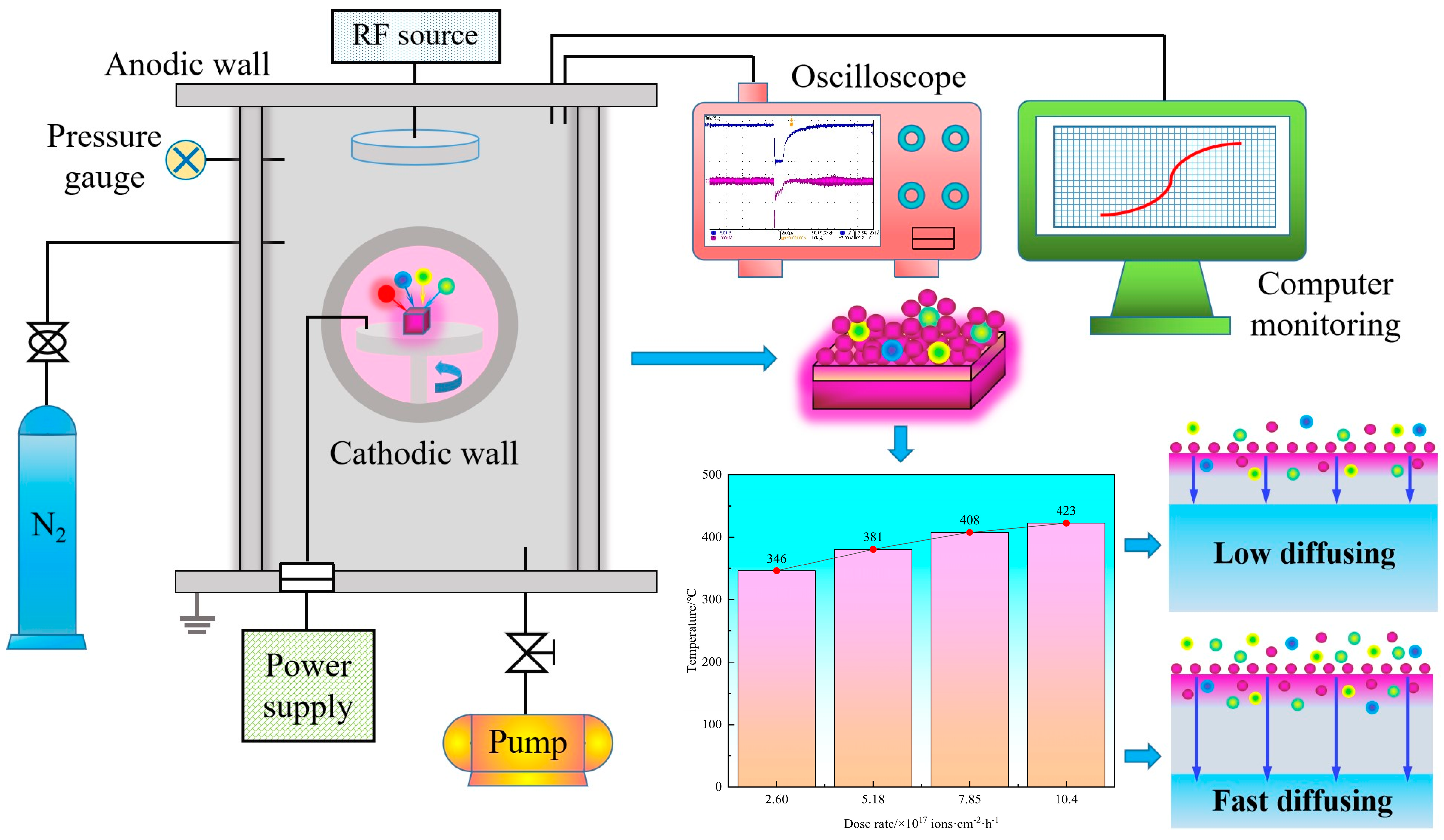

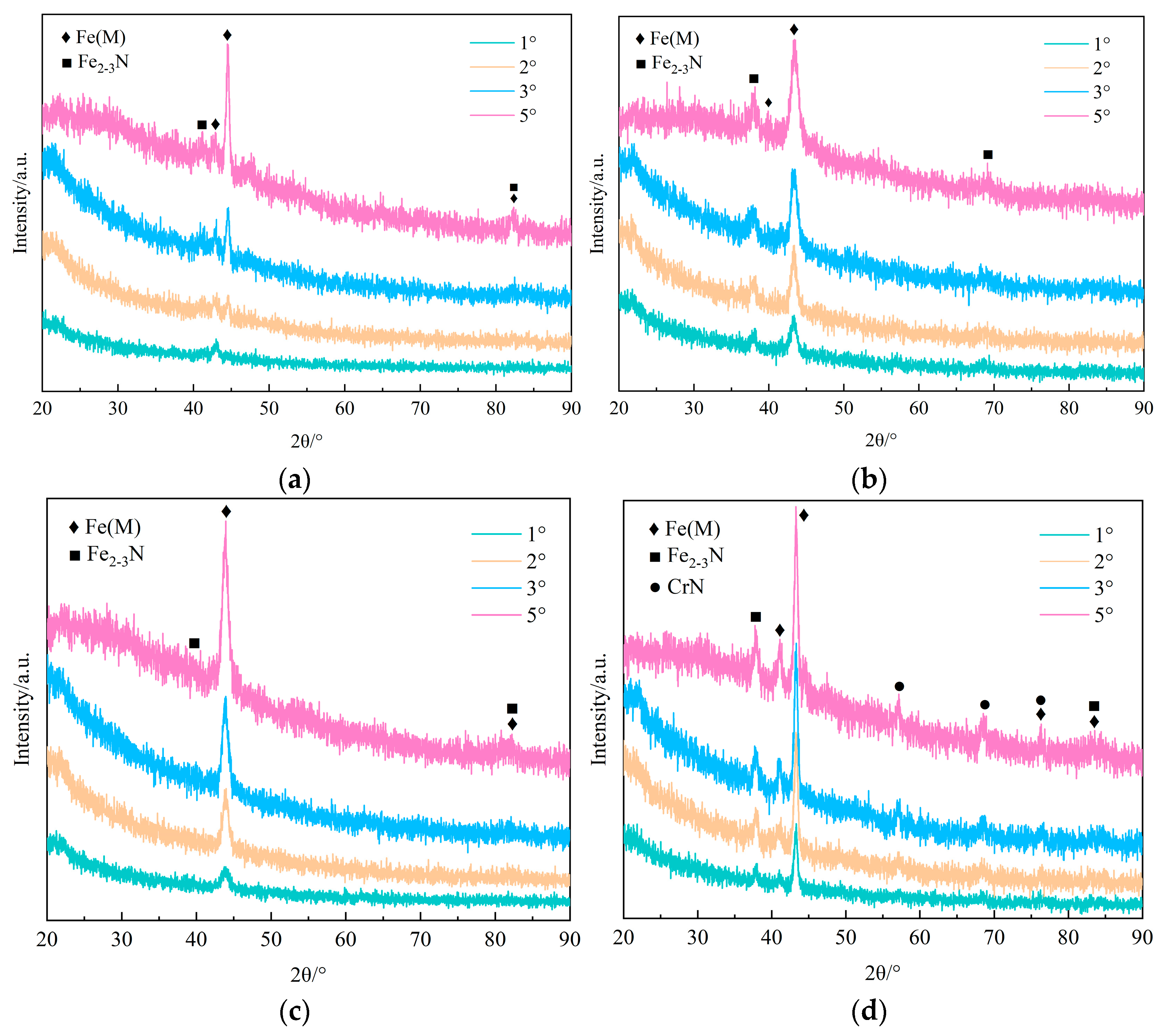


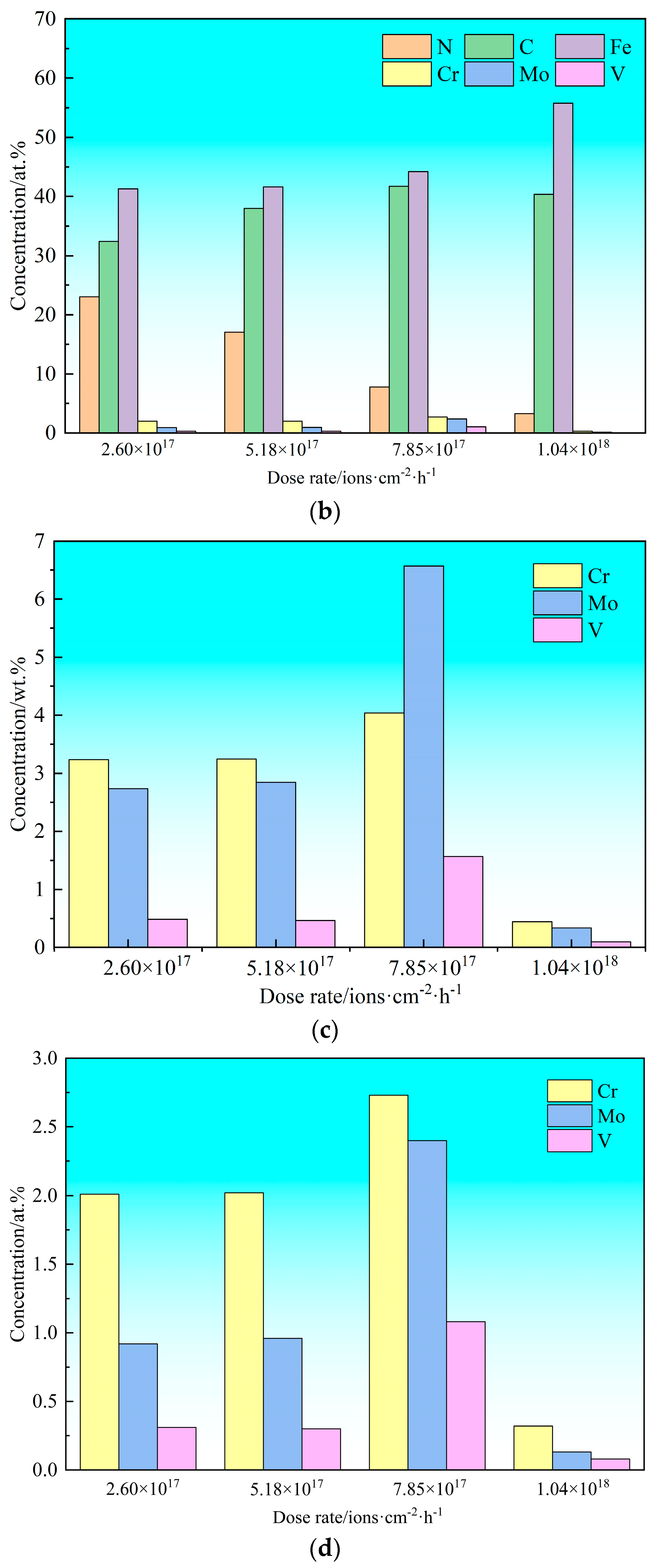
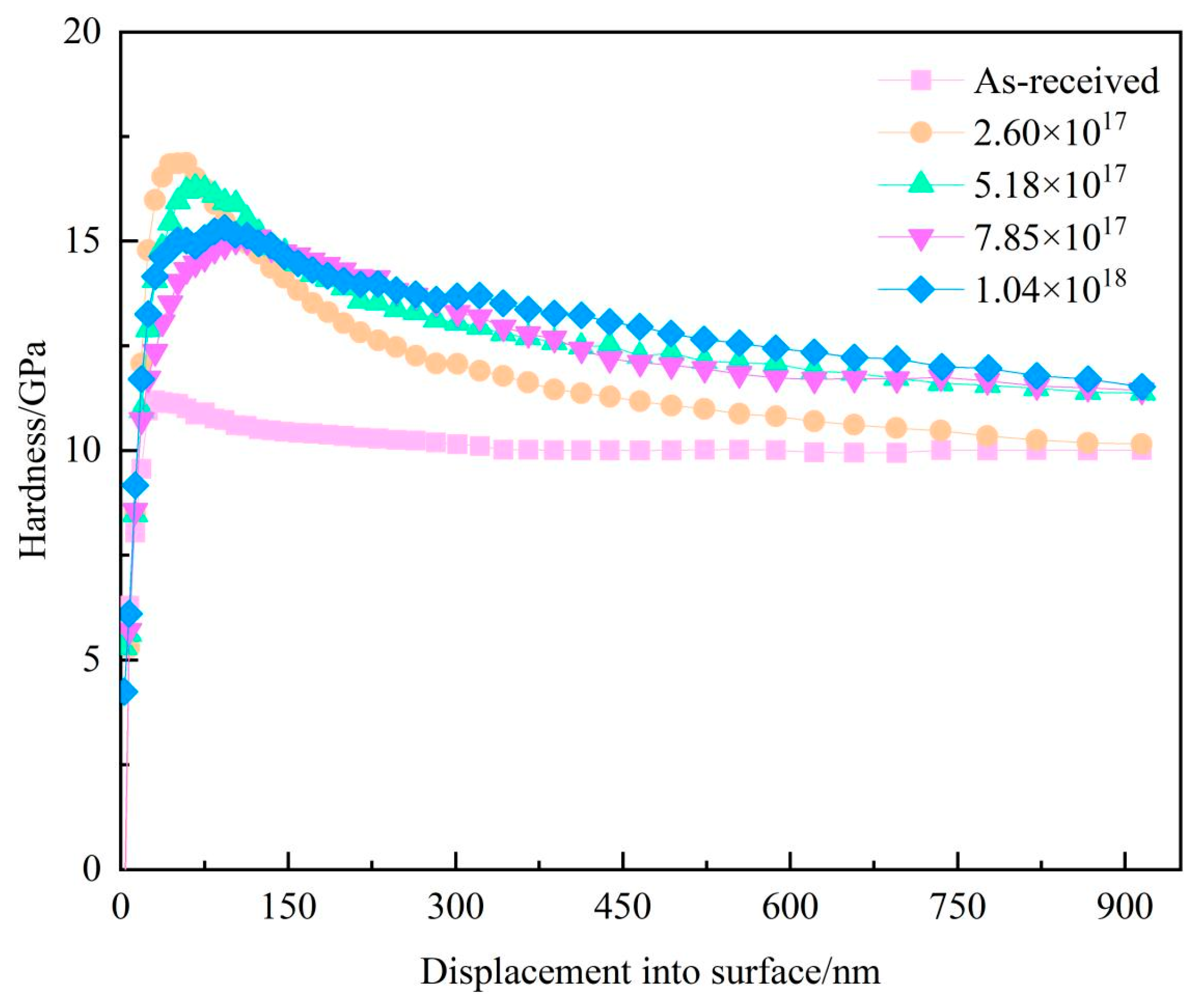
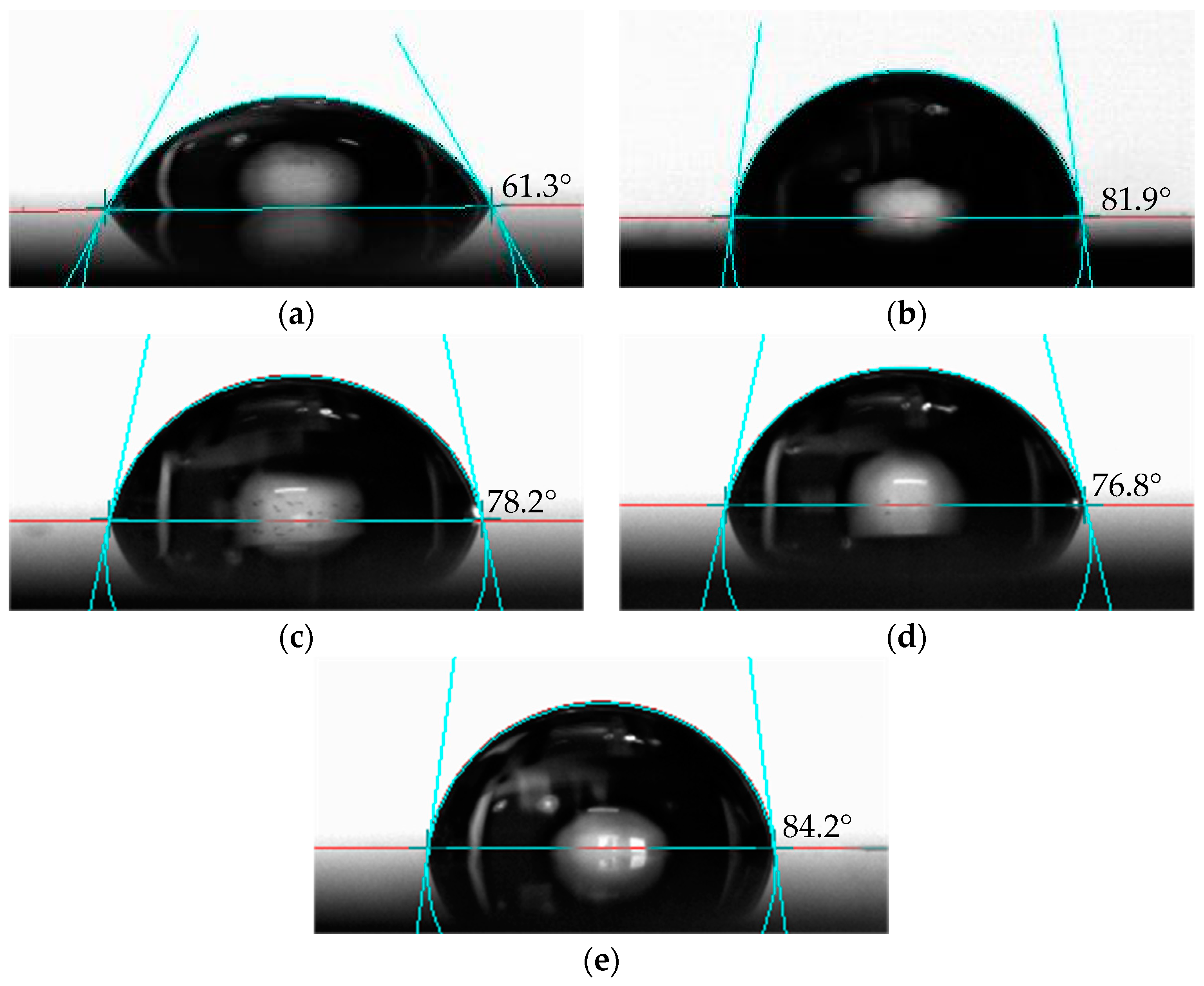


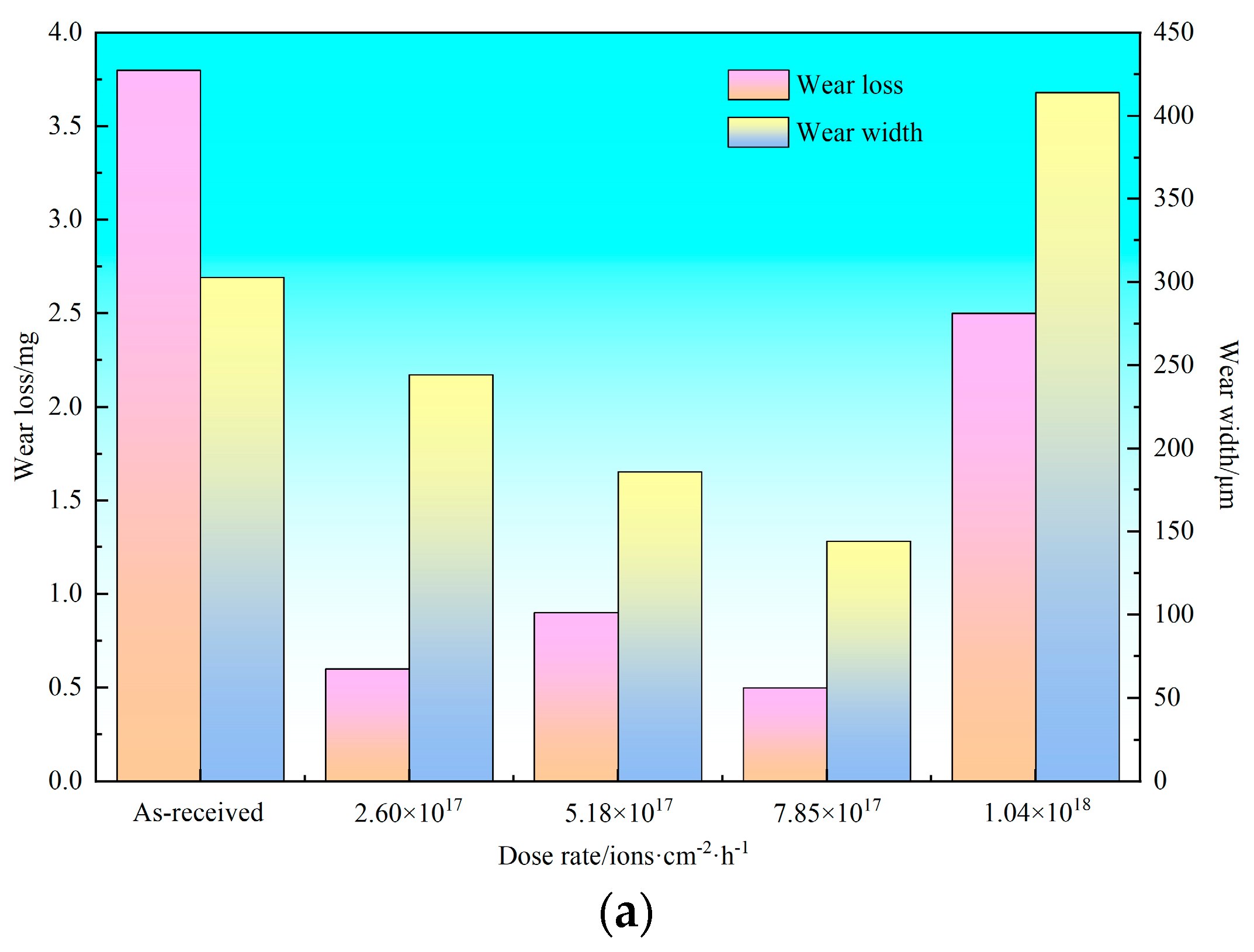

| C | Cr | Mo | V | Ni | Mn | Si | Co | W | Fe |
|---|---|---|---|---|---|---|---|---|---|
| 0.80~0.85 | 4.00~4.25 | 4.00~4.50 | 0.90~1.10 | ≤0.15 | 0.15~0.35 | ≤0.25 | ≤0.25 | ≤0.25 | Bal. |
| Elements | ||||||||||||
|---|---|---|---|---|---|---|---|---|---|---|---|---|
| C Kα | N Kα | Fe Kα | Cr Kα | Mo Lα | V Kα | |||||||
| Dose rate (ions/cm2·h) | Wt % | At % | Wt % | At % | Wt % | At % | Wt % | At % | Wt % | At % | Wt % | At % |
| 2.60 × 1017 | 12.06 | 32.41 | 10.01 | 23.05 | 71.47 | 41.30 | 3.240 | 2.01 | 2.74 | 0.92 | 0.49 | 0.31 |
| 5.18 × 1017 | 14.12 | 38.01 | 7.40 | 17.07 | 71.92 | 41.64 | 3.25 | 2.02 | 2.85 | 0.96 | 0.47 | 0.30 |
| 7.85 × 1017 | 14.29 | 41.73 | 3.13 | 7.84 | 70.40 | 44.22 | 4.04 | 2.73 | 6.57 | 2.40 | 1.57 | 1.08 |
| 1.04 × 1018 | 13.19 | 40.39 | 1.25 | 3.29 | 84.67 | 55.79 | 0.45 | 0.32 | 0.34 | 0.13 | 0.10 | 0.08 |
| Dose rate (ions/cm2·h) | 0 (As-received) | 2.60 × 1017 | 5.18 × 1017 | 7.85 × 1017 | 1.04 × 1018 |
| Average friction coefficient | 0.670 | 0.191 | 0.177 | 0.513 | 0.681 |
| Implantation Dose Rate (ions/cm2·h) | Contact Angles (°) | Surface Free Energy (mJ/m2) | |||||||
|---|---|---|---|---|---|---|---|---|---|
| 2.60 × 1017 | 81.9 | 69.9 | 39.0 | 19.0 | 21.8 | 51.0 | 15.3 | 45.3 | 61.4 |
| 5.18 × 1017 | 78.2 | 68.3 | 14.7 | 47.2 | 61.9 | ||||
| 7.85 × 1017 | 76.8 | 65.4 | 16.2 | 48.8 | 65.3 | ||||
| 1.04 × 1018 | 82.4 | 73.5 | 12.8 | 41.6 | 54.4 | ||||
Disclaimer/Publisher’s Note: The statements, opinions and data contained in all publications are solely those of the individual author(s) and contributor(s) and not of MDPI and/or the editor(s). MDPI and/or the editor(s) disclaim responsibility for any injury to people or property resulting from any ideas, methods, instructions or products referred to in the content. |
© 2024 by the authors. Licensee MDPI, Basel, Switzerland. This article is an open access article distributed under the terms and conditions of the Creative Commons Attribution (CC BY) license (https://creativecommons.org/licenses/by/4.0/).
Share and Cite
Miao, B.; Niu, J.; Guo, J.; Ding, Z.; Zhang, X.; Ma, X.; Wang, L. Effect of Dose Rate on Tribological Properties of 8Cr4Mo4V Subjected to Plasma Immersion Ion Implantation. Processes 2024, 12, 190. https://doi.org/10.3390/pr12010190
Miao B, Niu J, Guo J, Ding Z, Zhang X, Ma X, Wang L. Effect of Dose Rate on Tribological Properties of 8Cr4Mo4V Subjected to Plasma Immersion Ion Implantation. Processes. 2024; 12(1):190. https://doi.org/10.3390/pr12010190
Chicago/Turabian StyleMiao, Bin, Junbo Niu, Jiaxu Guo, Zifeng Ding, Xinghong Zhang, Xinxin Ma, and Liqin Wang. 2024. "Effect of Dose Rate on Tribological Properties of 8Cr4Mo4V Subjected to Plasma Immersion Ion Implantation" Processes 12, no. 1: 190. https://doi.org/10.3390/pr12010190
APA StyleMiao, B., Niu, J., Guo, J., Ding, Z., Zhang, X., Ma, X., & Wang, L. (2024). Effect of Dose Rate on Tribological Properties of 8Cr4Mo4V Subjected to Plasma Immersion Ion Implantation. Processes, 12(1), 190. https://doi.org/10.3390/pr12010190






